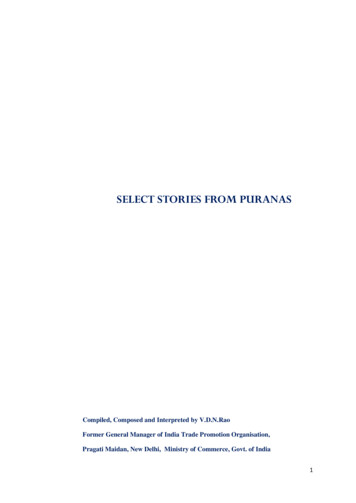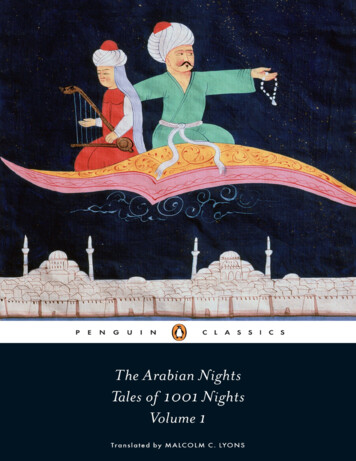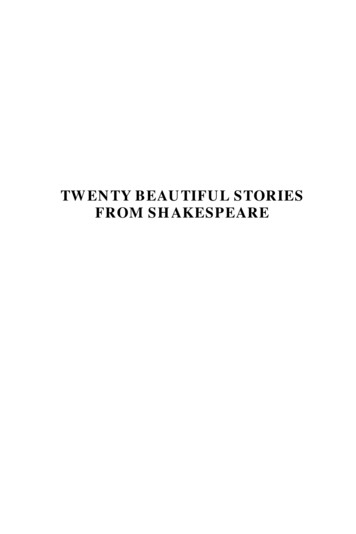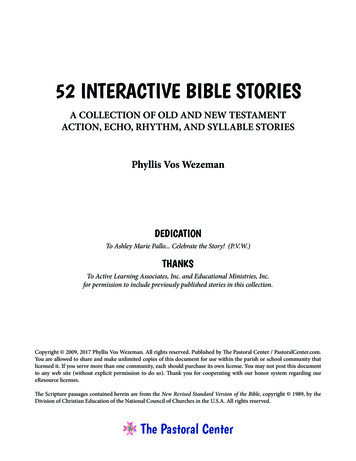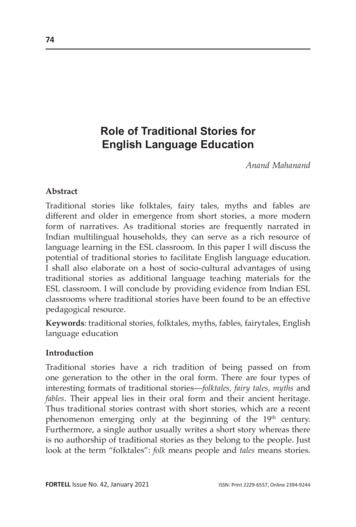
Transcription
74Role of Traditional Stories forEnglish Language EducationAnand MahanandAbstractTraditional stories like folktales, fairy tales, myths and fables aredifferent and older in emergence from short stories, a more modernform of narratives. As traditional stories are frequently narrated inIndian multilingual households, they can serve as a rich resource oflanguage learning in the ESL classroom. In this paper I will discuss thepotential of traditional stories to facilitate English language education.I shall also elaborate on a host of socio-cultural advantages of usingtraditional stories as additional language teaching materials for theESL classroom. I will conclude by providing evidence from Indian ESLclassrooms where traditional stories have been found to be an effectivepedagogical resource.Keywords: traditional stories, folktales, myths, fables, fairytales, Englishlanguage educationIntroductionTraditional stories have a rich tradition of being passed on fromone generation to the other in the oral form. There are four types ofinteresting formats of traditional stories—folktales, fairy tales, myths andfables. Their appeal lies in their oral form and their ancient heritage.Thus traditional stories contrast with short stories, which are a recentphenomenon emerging only at the beginning of the 19th century.Furthermore, a single author usually writes a short story whereas thereis no authorship of traditional stories as they belong to the people. Justlook at the term “folktales”: folk means people and tales means stories.FORTELL Issue No. 42, January 2021ISSN: Print 2229-6557, Online 2394-9244
Role of Traditional Stories for English Language Education75So they are people’s stories. Thus, we have Naga folktales, Nigerianfolktales, Tamil folktales, Telugu folktales, Garhwali folktales, and so on.Since in this paper I will discuss the role of traditional stories in ESLteaching, it will be useful to understand the definitions of the four formsof traditional stories. Though all these are usually oral narratives passedon from generation to generation, each has its own set of distinctivefeatures. Folktales are related to the everyday reality of human beingslike we find the story revolving around a farmer going to the field towork, or a woodcutter going to the forest to collect wood and others. Infairy tales, fantasy is the dominant element where we meet charactersthat can be as tall as trees, or can swim seven seas and thirteen riversin a second. A popular example of a fairy tale is Alice in Wonderland. Weknow how Alice shrinks by drinking the content from a bottle kept inthe rabbit hole. Another example is the story of Bikram and Betal thattells the tale of an Indian king and a spirit. Since fairy tales are based onfantasy, they are not so much related to everyday reality of human lifeunlike folktales. Fables are also stories but they have animals and otherliving beings who act as characters. Aesob’s Fables and the Jataka Talesare examples of fables. Myths have gods, goddesses and supernaturalbeings as characters and various such examples abound in the Indianepics of the Ramayana, Mahabharata and the graphic stories from Amarchitra katha. All these narratives are closely linked to the socio-culturalimages of a nation and have a deep impact on human life. One commonfeature that folktales, fairy tales, myths and fables have is that all ofthem weave stories using local incidents.Storytelling as a Language-Teaching ToolStorytelling has been an age-old form of teaching and has been usedby teachers from the olden days to educate people. The ancient cavepaintings and stone inscriptions show the relationship between storytelling and pedagogy and epitomize the rich storytelling tradition ofIndia. Even sages and religious teachers used this form to educatepeople across different ages. There is a story as to how the Panchatantrawas written. The story goes like this: A king had three sons. They werenot at all motivated to learn. The king was really worried about theireducation. On the advice of his ministers, he summoned a sage calledVishnu Sharma and explained the problem to him. After listening to theking, Vishnu Sharma promised to educate the three princes. And for thatISSN: Print 2229-6557, Online 2394-9244FORTELL Issue No. 42, January 2021
76Anand Mahanandpurpose, he wrote the Panchatantra and was successful in educating theprinces through the tales he wrote in that book.Stories have soothing effects on the listeners. In ancient days, whena psychologically disturbed patient went to the medicine man, themedicine man would prescribe medicine and along with it, he wouldprescribe a folktale to the patient. Even in modern times we use thestructure of a story to develop rhetoric and writing. There is a bookcalled Aesop and the CEO: Powerful Business Insights from Ancient Aesob’sFables by David Noonan (2005). Here the author uses Aesop’s fables toteach business skills to CEOs.India has a rich tradition of storytelling known as the Katha tradition.Indian texts such as the Jataka tales, Suka Saptati, Kathasaritasagara,Dasakumaracharita and Panchatantra are narratives rich in this form. Eventhe Ramayana and the Mahabharata are full of stories and all these occupyan important place in our cultural and moral ethos and pedagogy eventoday. One may ask but all these texts are written narratives. How canthey be called folk narratives? The response to this question would bethat they were in oral form earlier and were put in the written formmuch later.Stories have a number of pedagogic features that facilitate languageeducation (Taylor, 2000; Rinvolucri & Morgan, 1983). According to thesewriters, stories can be easily accessed and used as they are available innewspapers, magazines and in children’s literature. They can be adaptedand used in the language classes too. In places, where technology isnot available, the teacher can just narrate stories. They further state thatstories infuse interest and excitement in the learners without which alesson might be considered dry and uninteresting. Stories serve in themaintenance and regeneration of culture. Our cultural practices andtraditions are not only documented in stories, but are also passed fromone to the other generation. In other words, stories are a good means ofenriching cultural literacy and preserving cultural practices.We use stories because they are widely available. They can be narratedby elders and teachers to the learners. They serve as motivatingmaterials for learners. They are also suitable for use in the languageclassroom because of their lexical richness. Furthermore, stories arean excellent resource to teach inference generation to young learners.The brevity of a regular story ensures that it does not require moreFORTELL Issue No. 42, January 2021ISSN: Print 2229-6557, Online 2394-9244
Role of Traditional Stories for English Language Education77than one or two sessions. When a learner finishes reading a story, he/she has a sense of achievement. In addition to the potential of storiesdiscussed so far, I would like to specifically elaborate on the advantagesof using traditional stories in the language classroom as four significantadvantages in the following section. They are discussed as they wouldserve to raise awareness of Indian ESL teachers and make them moreopen to using this resource in their pedagogical practices.1. Language EnrichmentIn the field of language education, one of the significant frameworks is thatof Willis (1996) as she theorizes that learners require three conditions forlanguage learning: 1. Exposure to accessible language, 2. Opportunitiesto use the target language and 3. Motivation to learn. Stories readilyprovide all these three conditions. The text of a story provides exposureto different aspects of language such as syntactical patterns, vocabulary,and communicative use through a narrative discourse. Stories engagethe language learners with a variety of activities, which enable them toacquire competence and use the language features in day-to-day life.Stories transcend age barriers and are liked by the young and adultsalike. Psychologists believe that storytelling gives a child a play-likeexperience. Storytelling also brings in a relaxed atmosphere to theclassroom. With storytelling, there is no barrier between the teacherand the taught. Thus, storytelling facilitates a stress-free learningenvironment.The advantage of a traditional story is that it is well structured and linearin the progression of events. It has a beginning, climax and a happyending. In contrast, a modern short story may not always follow thisstructure and can have a reverse order when it can begin from the end.Learners are familiar with the traditional structure because they hearsimilar stories quite frequently at home. So it is the previous knowledgeor schema that helps them comprehend a story well. The structure canhelp them predict the sequence of events while characters’ emotions andintentions can be easily inferred. Thus, using the story grammar (Meyer& Rice, 1984), we can create a variety of tasks to make learners predictthe events and draw inferences. One such task would be to ask learnersto retell the stories in a language they know well after they have heardthe story in English.We can also use frequently occurring sentence structures present in theISSN: Print 2229-6557, Online 2394-9244FORTELL Issue No. 42, January 2021
78Anand Mahanandstory text and prepare tasks to help learners use those structures foreveryday communication. Let us look at an example to achieve such alearning goal. I have written the following story taking the idea froma folktale. The text is written to suit the language learning needs oflearners who have exposure to English through the classroom contextfor two or more years.From this text a few sentences can be picked up to teach two structures:(i) simple yes/no questions with use of modals (e.g. can, do, will) and(ii) mono-clausal sentences to express likes and dislikes. Note that thequestion structures are in italics whereas the answers and expressions oflikes/dislikes are mono-clausal sentences and are underlined. Throughthese two structures we can help learners use them for communicativepurposes. They can ask questions to each other to find out their hobbies:“Can you dance? Can you paint? Do you like to draw? Will you play with me?Furthermore, they can also express their likes and dislikes using monoclausal sentences like “I like painting. I don’t like swimming” and so on.Additional grammatical features like converting direct to reported speechcan also be taught using the same story. From the above discussion itis clear that traditional stories can facilitate language enrichment. Apartfrom these, it is possible to design “information gap activities, opiniongap activities and reasoning gap activities” as suggested by Prabhu(1987: pp. 46-47) and such activities are appropriate for communicativelanguage teaching.Research has shown that like music and dance, storytelling can also beperformative and its interactive quality helps in developing students’comprehension and production skills bilingually. For instance I haveconducted research to develop language skills of learners using mybook (Mahanand & Goswami, 2015) with a group of primary schoolFORTELL Issue No. 42, January 2021ISSN: Print 2229-6557, Online 2394-9244
Role of Traditional Stories for English Language Education79learners in Bargarh district of Odisha in 2018. I used ten local folktalesand gave them bilingual tasks to develop their language skills with afocus on vocabulary. I taught them reading by using a local folktalecalled “Topoi” or “Satbahani Kahani” (the story of the seven sisters).The story is about seven brothers and their only sister Topoi. The sevenbrothers go on business to another country keeping their only sister incustody of their wives. Topoi is ill-treated by her sisters-in-law duringthis period. When the brothers are back, Topoi complains against hersisters-in-law and her brothers punish them. This is a popular story thatthe learners were already familiar with. So when I mentioned the titleof the story, they took an immediate interest and exclaimed, “ Yes, weknow the story!” and were highly motivated to interact. So I asked themto retell the story in Odia and the children were fluent in this task. ThenI asked them to read the story in English and followed it by posingsome comprehension questions. They could comprehend the questionsand they answered in Odia. As a last task they also made attempts toretell the story in English mixing Odia words and phrases. Throughoutthe exercise the learners took a keen interest in reading the stories andsolving the linked language tasks. Consequently, their language skillsimproved over a period of time.2. Language Awareness Through Interactive LearningBy reading stories we become critically aware of different uses andexpressions of language used in different social contexts and differentspeech communities. For instance, one can be exposed to the use ofdouble negatives from African folktales. If a character says, “I don’tknow nothing”, he means, “I know nothing.” This is a deviated form oflanguage; but by using this we can teach learners the so-called “normal”or “standard” forms. Learners also pick up registers of different domainssuch as Nature, Mythology, Medicine and Sociology from stories. Takefor instance that certain linguistic expressions have come from traditionalstories and have become part of our everyday repertoire. For instance,opening a Pandora’s box, stepmotherly treatment, Cinderella syndrome, uglyduckling have come from folktales/fairytales and are used as everydayexpressions even in the present times.Storytelling is an interactive activity where both the teller and thelistener take an active part. Teaching through stories can also beinteractive. Here the teacher and the learners interact freely. InteractionISSN: Print 2229-6557, Online 2394-9244FORTELL Issue No. 42, January 2021
Anand Mahanand80can also happen among the learners themselves. Language awarenessabout the genre of narration where many dialogues are used, lend aparticipatory quality that any language teacher can use to generate alot of discussion in class and develop spoken skills in English or acrosslanguages. For instance enacting stories or retelling them can helpchildren use lexical chunks, idiomatic expressions, figurative speech andset phrases (e.g. at the beginning, long ago, and they lived happily ever after)to mark plot progression. Furthermore, children can be encouraged toprepare bilingual dialogues and teachers can help them find equivalentmetaphors and idioms across languages for example, a stitch in time savesnine; once in a blue moon; spill the beans (Bortfeld, 2003). Such activitiesare interactive, rich in language use for narrative and literary purposesand would help in developing fluency across languages (English andlearners’ L1).3. Critical Thinking and Literary AppreciationBy using stories we can develop learners’ higher order critical thinkingskills. It is generally thought that folktales are meant for enjoyment.But one might have observed that some folktales present certain peoplein a stereotypical manner. Characters in stories are often presentedas cunning, foolish or lazy. Hence learners should learn to read suchcharacter portrayals critically by questioning the stereotypical notionsand beliefs. For instance, in Indian folktales, the barber or “Napita” isportrayed as treacherous. He is courteous to the people in the village butreports all cases to the king.Let me share my experience of teaching critical thinking skills usingEnglish through Folktales: A self-study book (Mahanand & Goswami,2015). In this book we included 16 Odiya folktales we had heardorally and recreated them by writing them in English. It was designedto become a supplementary reader to develop all four skills in anintegrated manner (sans any overt focus on form teaching): Each taleis followed by comprehension questions with short answers, true/falsestatements, vocabulary exercise and writing tasks. Let us look at a fewcomprehension questions that deal with critical thinking skills, whichrequire the learners to go beyond the text to interpret the characters. Inone story, a character named Dhramapada is critically interpreted as heembraces death and makes a sacrifice to help sculptors finish buildingthe Konark temple. Three questions are included to involve students inFORTELL Issue No. 42, January 2021ISSN: Print 2229-6557, Online 2394-9244
Role of Traditional Stories for English Language Education81a critical interpretation of the character: “What bothered the artisans?How did Dharma come to their rescue? Why did Dharma decide to falldown from the temple?” along with a writing prompt: “Write an essayon the character of Dharma.” (pp. 42-49). The discussion on what ledDhramapada to sacrifice his life and what is the relationship of a boywith his parents are issues that students need to respond to using theircritical thinking skills. It would make them ask questions and verifyfacts instead of believing things at their face value. If we don’t thinkcritically, we will end up believing what we read or hear. Thus, usingstories we can educate learners to analyse characters and appreciatethem. Activities of different kinds can be designed to teach social valuesand enhance critical thinking skills.4. Inter-cultural AwarenessStories as a genre have a great potential in the ESL classroom as theypromote “cultural knowledge.” Learners learn about their own cultureas well as the culture of other places by reading stories.The National Curriculum Framework (2005) recommends the use ofstudents’ local language, traditions, skills including tales and proverbsin the textbooks. Providing children with the home environment isdefinitely needed to stimulate an interest to learn. The writers of thePosition Paper of National Focus Group on Teaching of English ”(2006, p.v) urge for providing an ‘input-rich’ environment. According to thesewriters, input-rich communicational environments are prerequisitesfor language learning. They emphasize the art of storytelling and storyreading and not so much teaching of stories as texts. Story reading (asopposed to teaching stories as texts) can be developed into a classroommethodology within a Whole Language approach. Reading stories outaloud, repeated reading, choral reading, story retelling and rewritingactivities can draw on and build on the existing language proficiencyand skills of teachers. Regular story reading triggers the acquisitionprocess in children and will encourage reading in both the teacher aswell as the pupil.The Draft National Education Policy of 2019 adds, India has a rich heritageof ancient knowledge, culture and language as the guiding light for thepolicy. The policymakers state that using a nation’s rich heritage andculture to develop the nation is important. Stories are a potent mediumto achieve this as they promote moral values for peaceful coexistence. ByISSN: Print 2229-6557, Online 2394-9244FORTELL Issue No. 42, January 2021
Anand Mahanand82teaching learners through traditional stories we can enrich their experiencein class with the precious wealth of knowledge related to Indian cultureand heritage. Stories can even be used to teach literary theory. Conceptslike power relations in Marxism, Feminism, and Psychoanalytic theorycan be explained using stories as examples. Exposure to stories and theirvarious aspects are likely to prompt learners to create stories of theirown. Maley (1997) and Wright (1997) have made commendable effortsin this direction. They have been successful in making learners writewonderful stories.ConclusionThus, we can conclude that traditional stories have enormous potentialfor language enrichment, language awareness and cultural and literaryappreciation in the ESL classroom. The familiarity and previousknowledge of learners can drive their anxiety away and motivate themto use languages for real-life communication. We should try to utilizeour learners’ previous knowledge to teach a language like Englishwhich is not available to many of them as a home language. From theabove discussion and examples, it becomes believable that traditionalstories are a helpful resource material for English language education.It is hoped that both teachers and learners would use such a potentialresource. In Telugu language, at the end of the story, the storytellerconcludes by saying “ katha kanchiki mana muintiki” meaning the storywent to Kanchi and we came home. So like that, my story is over fornow.ReferencesBortfeld, H. (2003). Comprehending idioms cross-linguistically. ExperimentalPsychology, 50(3), 217-230.Das, S.K. (Ed.). (2012).The English writings of Rabindranath Tagore (Vol. II). SahityaAkademi.Draft National Education Policy. (2019). https://www.mhrd.gov.in/sites/upload files/mhrd/files/Draft NEP 2019 EN Revised.pdf retrieved onAugust 20, 2020.Mahanand, A., & Goswami, L. (2015). English through Folktales: A self-study book.Viva Books Private Limited.Maley, A. (Ed.). (1997). Creating stories with children. OUP.Meyer, B.J., & Rice, G.E. (1984). The structure of text. In B.R. et al. (Eds.), HandbookFORTELL Issue No. 42, January 2021ISSN: Print 2229-6557, Online 2394-9244
Role of Traditional Stories for English Language Education83of reading research, 4 (pp. 155-192). CUP.National Council of Educational Research and Training. (2005). NationalCurriculum Framework (NCF). NCERT.National Council of Educational Research and Training. (2006). Position Paper ofthe National Focus Group on Teaching of English. NCERT.Noonan, D. (2005). Aesop and the CEO: Powerful business insights from Aesop’sancient fables. Nelson Business.Prabhu, N.S. (1987). Second language pedagogy. Oxford University Press.Rinvolucri, M., & Morgan, J. (1983). Once upon a time: Using stories in the languageclassroom. CUP.Taylor, E. (2000). Using folktales. CUP.Willis, J. (1996). A framework for task-based learning. Longman.Wright, A. (1997). Creating stories with children. OUP.Anand Mahanand is Professor in the Department of Materials Development, Testing andEvaluation at The English and Foreign Languages University, Hyderabad. His researchinterests include folklore and materials development.anand@efluniversity.ac.inISSN: Print 2229-6557, Online 2394-9244FORTELL Issue No. 42, January 2021
epics of the Ramayana, Mahabharata and the graphic stories from Amar chitra katha. All these narratives are closely linked to the socio-cultural images of a nation and have a deep impact on human life. One common feature that folktales, fairy tales, myths and fables have








